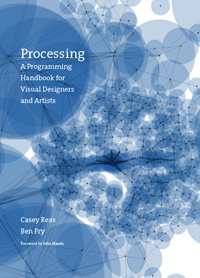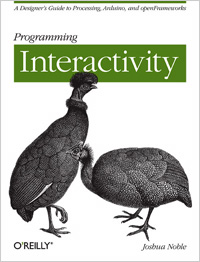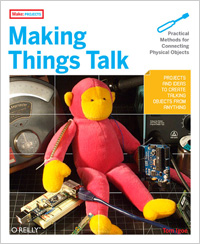 |
Processing: A Programming Handbook
for Visual Designers and Artists
Casey Reas and Ben Fry (Foreword by John Maeda).
Published 24 August 2007, MIT Press. 736 pages. Hardcover.
Order from Amazon.com
Compare prices (isbn.nu)
Buy local (BookSense.com, US only)
Downloads:
Table of Contents and Index (PDF, 500 KB)
Sample Chapters with Contents and Index (PDF, 7.6 MB)
All code examples in the book (ZIP, 15 MB)
Errata (Updated 22 April 2010)
This book is an introduction to the ideas of computer programming within the context of the visual arts. It targets an audience of computer-savvy individuals who are interested in creating interactive and visual work through writing software but have little or no prior experience. It is the result of six years of software development and teaching experience. The ideas presented have been continually tested in the classrooms, computer labs, and basements of universities, art and design schools, and arts institutions.
The majority of the book is divided into tutorial units discussing specific elements of software and how they relate to the arts. These units introduce the syntax and concepts of software such as variables, functions, and object-oriented programming. They cover topics such as photography and drawing in relation to software. These units feature many short, prototypical example programs with related images and explanation. More advanced professional projects from diverse domains including
animation, performance, and typography are discussed in interviews with their creators. The extension sections present concise introductions to further domains of exploration including computer vision, sound, and electronics.
Essays by Alexander R. Galloway, Golan Levin, R. Luke DuBois, Simon Greenwold, Francis Li, and Hernando Barragan
Interviews with Jared Tarbell, Martin Wattenberg, James Paterson, Erik van Blockland, Ed Burton, Josh On, Jeurg Lehni, Auriea Harvey and Michael Samyn, Mathew Cullen and Grady Hall, Bob Sabiston, Jennifer Steinkamp, Ruth Jarman and Joseph Gerhardt, Sue Costabile, Chris Csikszentmihalyi, Golan Levin and Zachary Lieberman, and Mark Hansen.
If you are an educator, you can request a desk/exam copy from the MIT Press website. It's also possible to request a PDF preview.
|
 |
Programming Interactivity: A Designer's Guide to Processing, Arduino, and openFrameworks
Joshua Noble.
Published July 2009, O'Reilly. 736 pages. Paperback.
Order from Amazon.com
Order from O'Reilly
The O'Reilly website says, "Make cool stuff. If you're a designer or artist without a lot of programming experience, this book will teach you to work with 2D and 3D graphics, sound, physical interaction, and electronic circuitry to create all sorts of interesting and compelling experiences -- online and off. Programming Interactivity explains programming and electrical engineering basics, and introduces three freely available tools created specifically for artists and designers: Processing, Arduino, and OpenFrameworks." |
 |
Making Things Talk: Practical Methods for Connecting Physical Objects
Tom Igoe.
Published 28 September 2007, O'Reilly. 428 pages. Paperback.
Order from Amazon.com
Order from O'Reilly
This book focuses on networking electronic devices with Arduino and Wiring, but includes many examples that use Processing for graphics. The O'Reilly website says,
"Through a series of simple projects, this book teaches you how to get your creations to communicate with one another by forming networks of smart devices that carry on conversations with you and your environment. Whether you need to plug some sensors in your home to the Internet or create a device that can interact wirelessly with other creations, Making Things Talk explains exactly what you need... With a little electronic know-how, a couple of inexpensive microcontroller kits and some network modules to make them communicate using Ethernet, ZigBee, and Bluetooth, you can get started on these projects right away" |




